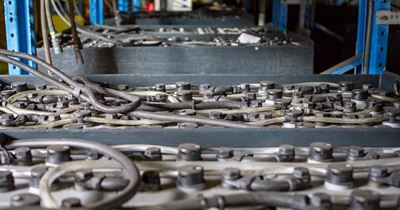10 Tips For Industrial Battery Handling Safety

Safety should be your top priority when managing industrial batteries. Review these 10 guidelines to keep you and your employees out of harm’s way.
Proper training is the single most effective safety tool that facility managers have at their disposal when managing industrial batteries. Employees that are properly trained and knowledgeable have fewer accidents. In the event that something does go wrong, a well defined action plan should be in place.
Only properly trained personnel should operate battery charging equipment or forklift battery changers, and anyone assigned to charging tasks should be knowledgeable about accident prevention and emergency management.
What To Wear
When handling or servicing batteries, workers should always wear protective clothing, including safety glasses, safety hats and acid resistant steel-toed boots. Workers that can be exposed to battery acid should also wear long sleeves and long pants, along with acid resistant gloves, arm protectors, aprons and face shields.
What Not To Wear
Workers that handle batteries should never wear metal jewelry or have metal tools strapped to their person. Obviously, metal is conductive and metal items can easily short circuit a battery and cause serious bodily harm.
No Flammable Materials
Gases produced by a battery can be explosive. It goes without saying that smoking is not allowed when handling batteries. Likewise, prevent sparks, open flames or electric arcs from occurring in or near charging areas.
Handling Fluids
Electrolyte and water levels should be checked before active charging begins, but no water should be added until after a charge is complete. Always pour acid into water when mixing the electrolyte, do not pour water into acid.
Check Vent Caps
Make sure that all vent caps are in place and are properly tightened. Keep them clean and dry to ensure an adequate seal.
Precautions For Battery Removal
When removing a battery from a forklift, the key should be turned to the “off” position to open the electrical circuit. The brake should be set and the wheels chocked so that the truck can’t move. The battery can then be unplugged and removed or charged in place.
A battery should never be moved by pulling its cables and batteries should only be charged or changed by personnel specifically trained in those procedures.
Use Caution When Connecting or Disconnecting
Keep the charger turned off and unplugged while attaching or detaching clamp connections.
Preventing Shorts
Use insulated tools when working with batteries.
Chain hoists used for removing batteries should always be equipped with a bucket or chain container to prevent shorts from any dangling length of chain. Alternatively, batteries can be covered with non-conductive material (e.g. plywood) to prevent an accidental short from the chain.
It’s a good idea to use a non-conductive battery beam with any type of hoist apparatus.
Battery Lifting
Battery beams distribute weight and reduce the chances of damaging the tray while lifting a battery. Steel-trayed batteries have eye holes to attach chain. Hoisting a battery without using a beam and simply hooking the chain to eye holes on the tray and directly lifting the battery can warp or damage the tray.
Counterbalance Weight
A battery service weight is usually stamped somewhere on the steel tray, generally near one of the eye holes. Before installing a new or different battery, it’s important to check the lift truck manufacturer’s recommended battery weight for the forklift. The wrong battery weight can alter the center of gravity for a truck and cause it to tilt or tip under load.
Talk To A Battery Expert
For assistance with industrial batteries or battery handling equipment, call a material handling expert at Raymond West today!

